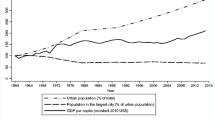Abstract
We report on a large-scale household survey conducted in the city of Nanjing, in 2005, which forms a preliminary study for a major ESRC/DFID funded investigation into urban poverty and property rights changes in China. To capture an initial portrait of the urban poor, the Nanjing study focuses on the most essential elements of their daily lives, i.e. demographic characteristics, access to social entitlements, housing conditions, neighbourhood interactions and social networks. It is the first study to comprehensively examine the morphology of urban poverty at the city scale. Urban Hukou (urban citizen rights) households with no unemployed member are found to be better off than working rural migrants. Urban Hukou households with at least one unemployed member have a similar poverty incidence to rural migrants; the latter suffering from a series of interrelated disadvantages. There are distinct groups of urban poor, each being affected by a particular set of impoverishing factors. Poor urban-registered households are typically characterised by unfavourable personal or household characteristics, such as a large number of dependent household members and prior employment in a state owned enterprise. The impoverishment of rural migrants is largely connected with institutional discrimination such as lack of rights to social security benefits and unfavourable employment opportunities.

Similar content being viewed by others
Notes
Respectively, the UK’s Economic and Social Research Council and Department for International Development.
Set locally by each city.
This includes migrants with rural hukou (registered in rural districts)—i.e. rural-urban migrant workers—and those with urban hukou from other towns and cities—i.e. urban-urban migrant workers. The former is the majority component.
Each city in China sets a minimum living standard, that takes into account prices of food, rent, labour and so on.
Strictly speaking, leasehold rights, which are transferable in the secondary housing market.
In the central planning era, work units functioned like micro territorial states, providing urban services and homes for their workers to the degree that they were able to retain part of their operational revenue before returning to higher levels of government. Workers in small and poor work units tended to rent homes in the dilapidated pre-1949 housing areas in the central city, or to live on in their own houses—but with little ability to maintain them and with no effective ownership rights.
References
Asian Development Bank (ADB) (2004). Poverty profile of the People’s Republic of China. Manila: ADB.
Alchian, A. A., & Demsetz, H. (1973). The property rights paradigm. Journal of Economic History, 3(1), 16–27.
Barzel, Y. (1997). Economic analysis of property rights. Cambridge, MA: Cambridge University Press.
Burt, J. E. (1996). Elementary statistics for geographers. New York: Guilford.
Fei, J. C. H., & Ranis, G. (1964). Development of the labor surplus economy. Homewood, IL: Irwin.
Gilbert, A. (1997). Employment and poverty during economic restructuring: the case of Bogota, Colombia. Urban Studies, 34(7), 1047–1070.
Herzberg, F. (1959). The motivation to work. New York: Wiley.
Hussain, A. (2003). Urban poverty in China: measurement and patterns policies. In Focus Programme on Socio-Economic Security, ILO, and Geneva. Retrieved from http://www.ilo.org/public/english/protection/ses/download/docs/china.pdf.
Khan, A., & Riskin, C. (2001). Inequality and poverty in China in the age of globalisation. New York: Oxford University Press.
Lewis, W. A. (1954). Economic development with unlimited supplies of labour. The Manchester School, 22, 139–191.
Li, S. (2006). Rising poverty and its causes in urban China. In S. Li, & H. Sato (Eds.), Unemployment, inequality and poverty in urban China (pp. 128–151). Abingdon, Oxon: Routledge.
Liu, Y. T., & Wu, F. L. (2006). Urban poverty neighbourhoods: typology and spatial concentration under China’s market transition, a case study of Nanjing. Geoforum, 37(4), 610–626.
Nanjing Statistical Bureau (2006). Nanjing Statistical Yearbook 2006. Beijing: China Statistics Press.
Solinger, D. J. (2002). Labour market reform and the plight of the laid-off proletariat. The China Quarterly, 158, 304–326.
Todaro, M. P. (1969). A model of labour migration and urban unemployment in less developed countries. The American Economic Review, 59, 138–148.
Wang, Y. P. (2004). Urban poverty, housing and social change in China. Abingdon, Oxon: Routledge.
Webster, C. (2007). Property rights, public space and urban design. Town Planning Review, 78(1), 81–101.
Webster, C., & Lai, L. W. C. (2003). Property rights, planning and markets: managing spontaneous cities. Aldershot: Edward Elgar.
Wong, C. K. (1995). Measuring 3rd-world poverty by the international poverty line—the case of Reform China. Social Policy & Administration, 29(3), 189–203.
Wong, C. K. (1997). How many poor people in Shanghai today? The question of poverty and poverty measure. Issues & Studies, 33(12), 32–49.
Wu, F. (2004). Urban poverty and marginalization under market transition: the case of Chinese cities. International Journal of Urban and Regional Research, 28(2), 401–423.
Xue, J., & Zhong, W. (2006). Unemployment, poverty and income disparity in urban China. In S. Li, & H. Sato (Eds.), Unemployment, inequality and poverty in urban China (pp. 43–64). Abingdon, Oxon: Routledge.
Zhang, L. (2001). Strangers in the city: reconfiguration of space, power, and social networks within China’s floating population. Stanford: Stanford University Press.
Acknowledgements
We would like to thank the anonymous reviewers for their useful and constructive comments. The research is supported by the ESRC/DFID Grant ‘Urban Poverty and Property Rights Changes in China’ (RES-167-25-0005). The usual disclaimers apply.
Author information
Authors and Affiliations
Corresponding author
Rights and permissions
About this article
Cite this article
He, S., Webster, C., Wu, F. et al. Profiling Urban Poverty in a Chinese City, the Case of Nanjing. Appl. Spatial Analysis 1, 193–214 (2008). https://doi.org/10.1007/s12061-008-9012-6
Received:
Accepted:
Published:
Issue Date:
DOI: https://doi.org/10.1007/s12061-008-9012-6




